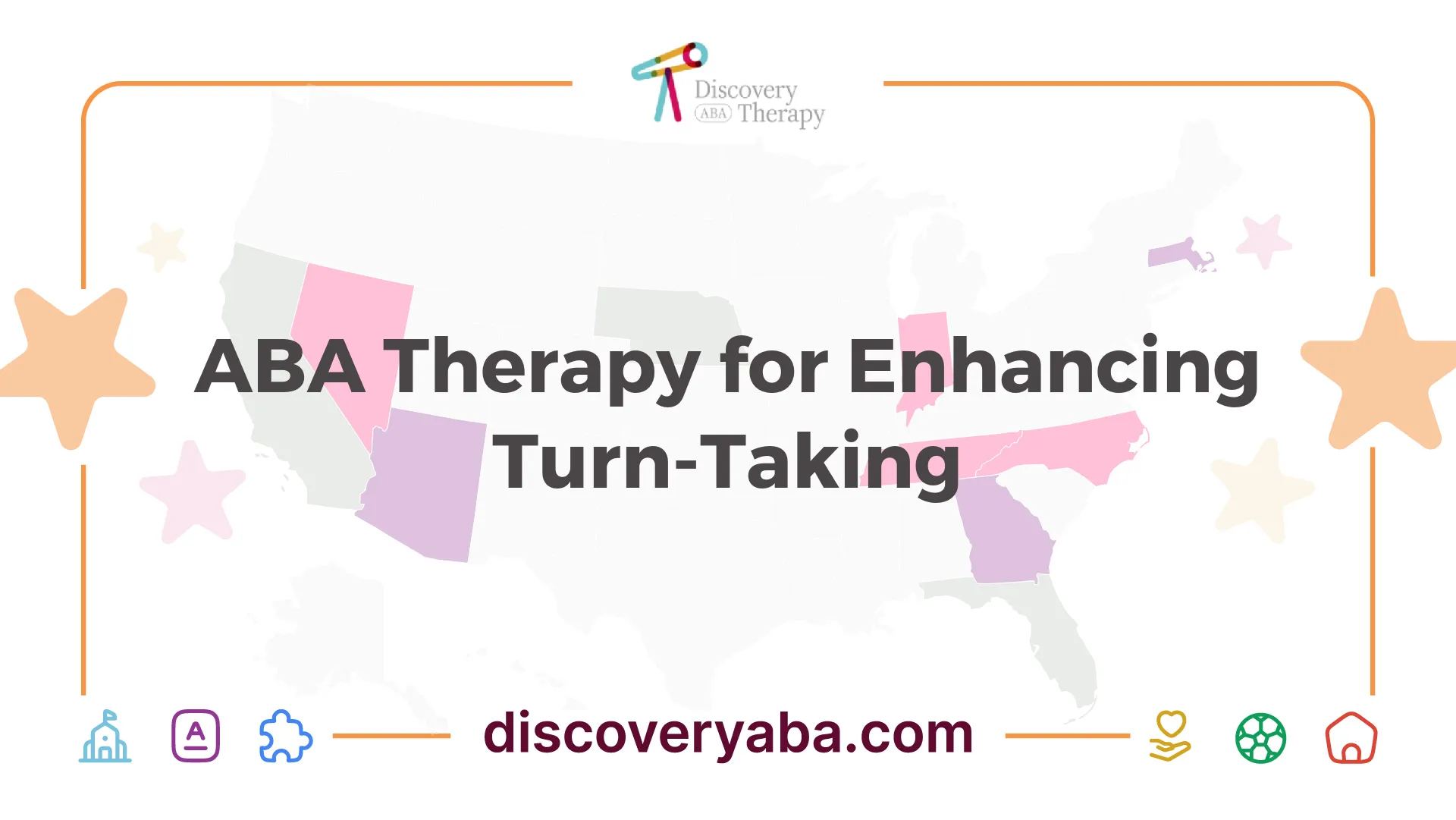ABA Therapy for Enhancing Turn-Taking
Discover effective strategies for improving turn-taking with ABA therapy and enhance social skills today!

ABA Therapy Overview

Benefits of ABA Therapy
Applied Behavior Analysis (ABA) therapy is designed to improve human behavior by identifying and modifying behaviors, particularly in individuals diagnosed with autism spectrum disorder. Through this approach, ABA therapy enhances overall functioning and quality of life [1]. The implementation of behavior analysis principles helps individuals develop essential skills while reducing problematic behaviors, leading to meaningful behavioral changes.
A substantial body of research highlights the effectiveness of ABA therapy for those on the autism spectrum. More than 20 studies have demonstrated that intensive and long-term ABA therapy significantly improves outcomes in various areas, including intellectual functioning, language abilities, daily living skills, and social skills.
Key Benefits of ABA TherapyImpact AreasRecognizes and reduces problematic behaviorsBehavioral ManagementEnhances communication and language abilitiesLinguistic SkillsImproves daily living and functional skillsLife Skills DevelopmentSupports social skill developmentInterpersonal Skills
Recognizing Behavioral Improvements
A significant study from the University of California at Los Angeles (UCLA) focused on the Young Autism Project model, revealing impressive outcomes. It showed that 47% of children with autism who participated in ABA treatment achieved normal intellectual and educational functioning. In contrast, only 2% of those in the control group reached similar levels, underscoring the therapy's effectiveness [3].
Recognizing behavioral improvements involves observing changes in various aspects of an individual's life, such as:
These indicators help parents and caregivers understand the progress being made through ABA therapy and can direct further interventions to enhance outcomes, particularly in areas like improving turn-taking with aba therapy. For further reading on specific applications of ABA, consider exploring topics such as aba for autism and sensory disorders or teaching functional life skills with aba.

Social Skills Training in ABA
Importance of Social Skills
Social skills are crucial for individuals, especially children with autism, as they facilitate successful interactions in various environments. The ability to make friends, communicate effectively, and engage in independent activities like grocery shopping can significantly enhance an individual's quality of life. Social Skills Training (SST) within ABA programs addresses these essential skills by promoting skill acquisition and enabling better interpersonal relationships.
Studies have shown that effective social skills intervention can reduce social anxiety and improve overall social interaction and emotional regulation in children with autism. Children often experience difficulties in communication, leading to feelings of isolation. By focusing on these areas, ABA programs can help individuals enhance their social capabilities in multiple settings.
Benefits of Social Skills TrainingReduces social anxietyImproves social interactionsEnhances communicationAids in emotional regulationIncreases opportunities for play and socialization
Teaching Social Skills with ABA
Teaching social skills through ABA typically involves Behavioral Skills Training (BST). This method incorporates several stages, starting with explaining the importance of the skill, followed by modeling the desired behavior. This approach allows the individual to understand the context and relevance of the skill in social settings.
The next components of BST involve guided practice, where the individual is given opportunities to apply the skill in a supportive environment. Continuous feedback is essential during this stage, as it reinforces correct execution and provides guidance for areas needing improvement.
Incorporating a combination of ABA and Developmental Social Pragmatic (DSP) models can also be beneficial in addressing social skill deficits, ensuring comprehensive support for individuals with autism. For further insights on related topics, such as improving focus and attention, explore our article on aba for focus and attention in autism.
By equipping individuals with the necessary social skills, ABA therapy can positively influence their ability to navigate everyday situations and relationships, leading to improved overall well-being.
Task Analysis in ABA
Understanding Task Analysis
Task analysis is a fundamental component of ABA therapy that enables therapists to identify the specific steps necessary to complete a skill or task. This approach simplifies the learning process for individuals, particularly those with autism spectrum disorder (ASD). By breaking complex tasks down into manageable segments, therapists can effectively teach and promote mastery of new skills [6].
The structured framework of task analysis provides numerous benefits in ABA therapy, including:
Benefits of Task AnalysisIndividualized instruction tailored to the learner's needsPromotion of independence in completing tasksEnhanced understanding of complex skillsClear roadmap for skill acquisition
By implementing task analysis, therapists can create customized teaching programs that align with the unique abilities and learning preferences of each individual (Adina ABA). This systematic approach ensures a higher likelihood of successful outcomes.
Implementing Task Analysis Techniques
To effectively implement task analysis in ABA therapy, therapists typically follow a series of steps:
Each of these steps plays a critical role in enhancing the overall effectiveness of the ABA intervention. By promoting independence, task analysis empowers individuals to generalize skills to daily activities, thereby increasing their adaptive functioning [6]. Implementing these techniques is particularly useful for improving turn-taking with ABA therapy, allowing individuals to engage more successfully in social interactions.
Therapists can also incorporate other strategies such as teaching functional life skills with aba and developing coping skills with aba alongside task analysis to reinforce learning and support the growth of essential social skills.
Behavioral Skills Training
Behavioral Skills Training (BST) is an essential component of Applied Behavior Analysis (ABA) aimed at teaching social skills. It involves a structured approach that provides individuals with opportunities to learn and practice essential skills such as turn-taking.
Components of BST
The effectiveness of BST as a teaching methodology in ABA is based on its core components. These include:
This structured method allows individuals to progressively improve their social skills, including skills related to improving turn-taking with ABA therapy.
Applying BST in ABA Programs
In ABA programs, BST can be implemented effectively to enhance various social skills. The application typically follows these steps:
StepActivity1Explain the importance of the skill (e.g., turn-taking in games)2Model the behavior by demonstrating an example of turn-taking3Engage the individual in guided practice, allowing them to take turns in a safe setting4Offer feedback on their performance, focusing on what they did well and areas for improvement
By systematically applying these components, parents and caregivers can foster an environment where individuals learn to interact more successfully with peers and develop critical social skills. For targeted interventions specific to social skills, additional resources include ABA for focus and attention in autism and teaching functional life skills with ABA.
BST not only helps improve social skills but also has applications in addressing various behavioral challenges. For instance, integrating BST practices can be beneficial in dealing with situations such as aba for autism and sensory disorders or addressing repetitive behaviors with aba. By leveraging these strategies, caregivers can support their loved ones in achieving meaningful behavioral change through consistent practice and encouragement.
Social Skills Training Techniques
Social skills training (SST) is essential for individuals with autism to enhance their interpersonal relationships and facilitate social interactions. Among the various techniques within SST, Behavioral Skills Training (BST) is a highly effective method.
BST and Social Skills
Behavioral Skills Training (BST) is utilized within ABA models to effectively teach social skills. The approach begins with explaining the significance of the target skill, followed by modeling the behavior, and then incorporating a gradual process of guided practice and feedback. This structured method reinforces learning and helps individuals understand the nuances of social interactions, such as turn-taking, conversation, and sharing [4].
When implementing BST, it's important to break down complex social skills into manageable parts. This systematic approach allows trainers to teach individual components, ensuring the learner grasps each element before moving to more complex interactions. For instance, in teaching turn-taking, the initial focus might be on recognizing when it is appropriate to take a turn, followed by practicing the action in a controlled setting.
Data Collection in Social Skills Training
Data collection is a fundamental aspect of assessing the effectiveness of social skills training. Tracking progress allows caregivers and practitioners to evaluate improvements in skills and adjust strategies as needed. Various data collection methods can be employed, including direct observation, behavioral rating scales, and anecdotal records.
Below is a sample table illustrating potential metrics for data collection in social skills training for improving turn-taking:
Skill ComponentInitial Baseline (Week 1)Week 4Week 8Progress (%)Recognizing turn-taking30%60%90%60%Actual turn-taking20%50%80%60%Response to cues25%55%85%60%
By analyzing this data over time, caregivers can identify specific areas where the individual is excelling or may need additional support. This allows for tailored interventions, ensuring that each person receives the specific help required to improve their social skills effectively.
Combining ABA techniques with Developmental Social Pragmatic (DSP) models can further enhance the effectiveness of SST interventions, especially in addressing social skill deficits in children with autism [5]. Continued use of data collection will support ongoing development and generalization of skills across various settings. For more information about utilizing ABA to teach functional skills, visit our articles on teaching functional life skills with aba and aba for autism and anxiety disorders.
Effective ABA Interventions
Applied Behavior Analysis (ABA) encompasses several effective intervention models aimed at enhancing the lives of individuals with Autism Spectrum Disorder (ASD). Among these models, the Early Intensive Behavioral Intervention (EIBI) has shown notable success in addressing various developmental challenges.
EIBI Model Overview
Early Intensive Behavioral Intervention (EIBI) is a well-established ABA model designed for children under the age of 5. This intensive program typically involves 20–40 hours of therapy per week over several consecutive years, focusing on essential areas such as cognition, language, social skills, problem behaviors, and daily living skills.
The EIBI model is notable for its structured approach, employing various ABA techniques tailored to the individual needs of each child. By engaging with children in a supportive environment, EIBI aims to facilitate significant improvements in their abilities and behaviors.
ABA ModelTarget AgeHours per WeekFocus AreasEarly Intensive Behavioral Intervention (EIBI)Under 520–40Cognition, Language, Social Skills, Problem Behavior, Daily Living Skills
The Surgeon General of the United States has endorsed ABA therapy, highlighting its effectiveness in improving communication and social behavior while reducing inappropriate actions. Comprehensive ABA models, such as EIBI, Early Start Denver Model (ESDM), and Learning Experiences: An Alternative Program for Preschoolers and Their Parents (LEAP), further contribute to advancing the application of ABA strategies for children with ASD.
Success of ABA Interventions
The success rates of ABA interventions have been well-documented over the past 60 years. As ABA has evolved, it has provided significant improvements for individuals across all functioning levels within the ASD spectrum [3]. These interventions have been successful in enhancing communication abilities, social skills, and daily living competencies.
Statistically, many children who undergo intensive ABA therapy experience substantial growth in areas previously identified as challenging. Overall, ABA therapy continues to be recognized as a vital approach for aiding individuals with autism, consistently yielding positive outcomes. For more information on related techniques, check out our resources on teaching functional life skills with aba, increasing eye contact with aba therapy, and developing coping skills with aba.
References
[2]:
[3]:
[4]:
[5]:
[6]:
Does Your Child Have An Autism Diagnosis?
Learn More About How ABA Therapy Can Help
Find More Articles
Contact us
North Carolina, Nevada, Utah, Virginia
New Hampshire, Maine
Arizona, Colorado, Georgia, New Mexico, Oklahoma, Texas
.avif)




































































































